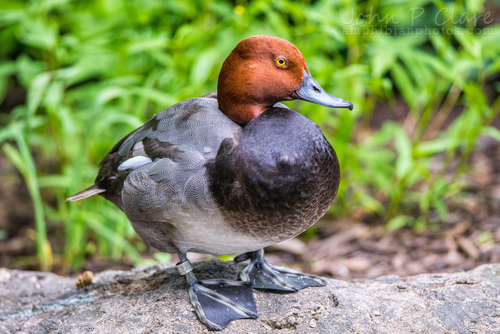
Redhead
The Redhead (*Aythya americana*) is a striking diving duck found in North America. Known for its vibrant rusty-red head in breeding males, this species plays a vital role in wetland ecosystems. It is a highly social duck, often found in large flocks during migration and winter. The Redhead has a somewhat complex relationship with other duck species, exhibiting brood parasitism, where females lay eggs in the nests of other ducks, particularly Canvasbacks.
42-49 cm
Length
79-89 cm
Wingspan
Least Concern
Conservation Status
Distribution
Breeds primarily in the prairie pothole region of North America (central Canada and northern United States). Migrates south to winter in the southern United States, Mexico, and parts of the Caribbean. Altitudinal range is generally from sea level to around 1,500 meters.
Lifespan
Up to 22 years in the wild, though most live significantly shorter lives (average is likely closer to 2-5 years).
Redhead's Habitat
Habitat Types
Freshwater marshes, Lakes, Ponds, Shallow bays, Coastal wetlands
Climate Zones
Temperate, Subarctic (breeding range), Subtropical (wintering range)
Adaptations
Feet positioned far back on the body, aiding in efficient diving but making movement on land somewhat awkward. They have a lobed hind toe (hallux) which helps with propulsion underwater.
Variations
No recognized subspecies.
Appearance
Breeding Plumage
Breeding males have a bright chestnut-red head and neck, black breast, and gray back. Females are a more subdued brown overall. Non-breeding males (eclipse plumage) resemble females but retain some reddish tones on the head.
Seasonal Feather Changes
Males undergo a complete molt after breeding, entering the eclipse plumage. They regain breeding plumage in the fall.
Sex Based Plumage Differences
Significant. Males are much more brightly colored during the breeding season.
Notable Features
Rounded head shape, Bluish-gray bill with a black tip, Yellow eyes in males, dark eyes in females
Diet and Feeding
Primary Foods
Aquatic plants (seeds, roots, tubers), Submerged vegetation (pondweeds, muskgrass), Aquatic invertebrates (insects, mollusks, crustaceans)
Foraging Behavior
Dives underwater to feed, typically in shallow water (less than 2 meters deep). They upend to reach vegetation and invertebrates on the bottom.
Specializations
Serrated bill edges help to strain food from the water and mud.
Seasonal Diet Variations
Diet shifts with availability. More invertebrates are consumed during the breeding season to provide protein for egg-laying and chick growth. Plant matter dominates during the winter.
Behavior
Social Structure
Highly gregarious, especially outside of the breeding season. Forms large flocks during migration and on wintering grounds. During breeding, they are more dispersed.
Communication
Soft 'meow' calls by females, Wheezy 'peep' calls by males, Visual displays during courtship
Migration
Migrates in large flocks, often following major river systems and coastlines. Travels at night and rests during the day.
Territorial or Group Behaviors
Males defend a small territory around the nest during the early stages of breeding, but this defense is not as strong as in some other duck species. Brood parasitism is common.
Conservation
Threats
Habitat loss and degradation (wetland drainage), Lead poisoning (from ingestion of spent lead shot), Collisions with power lines and other structures, Climate change (affecting breeding habitat)
Protection Programs
North American Waterfowl Management Plan, Wetlands Reserve Program, Conservation Reserve Program
Local National Laws
Protected under the Migratory Bird Treaty Act in the United States and Canada.
Population Trend
Stable
Population Estimates
Approximately 1.2 million individuals (estimated).
Interesting Facts
Redheads are known for their brood parasitism.
Females often lay eggs in the nests of other ducks, especially Canvasbacks, leaving the other species to raise their young.
They can dive to depths of up to 10 feet.
Although they usually feed in shallower water.
Large flocks can number in the thousands.
These large aggregations occur during migration and on wintering areas.
Faqs about Redhead
What is the difference between a Redhead and a Canvasback?
Male Redheads have a rounded, red head, gray back, and yellow eyes. Male Canvasbacks have a sloping forehead, a darker red head, a white back, and red eyes.
Are Redheads hunted?
Yes, Redheads are a popular game bird, and hunting is regulated to ensure sustainable populations.
Why do Redheads lay eggs in other ducks' nests?
This behavior, known as brood parasitism, may increase the chances of some offspring surviving, especially if the Redhead's own nest is destroyed or if resources are limited.
Copyright @ Nature Style Limited. All Rights Reserved.
 English
English